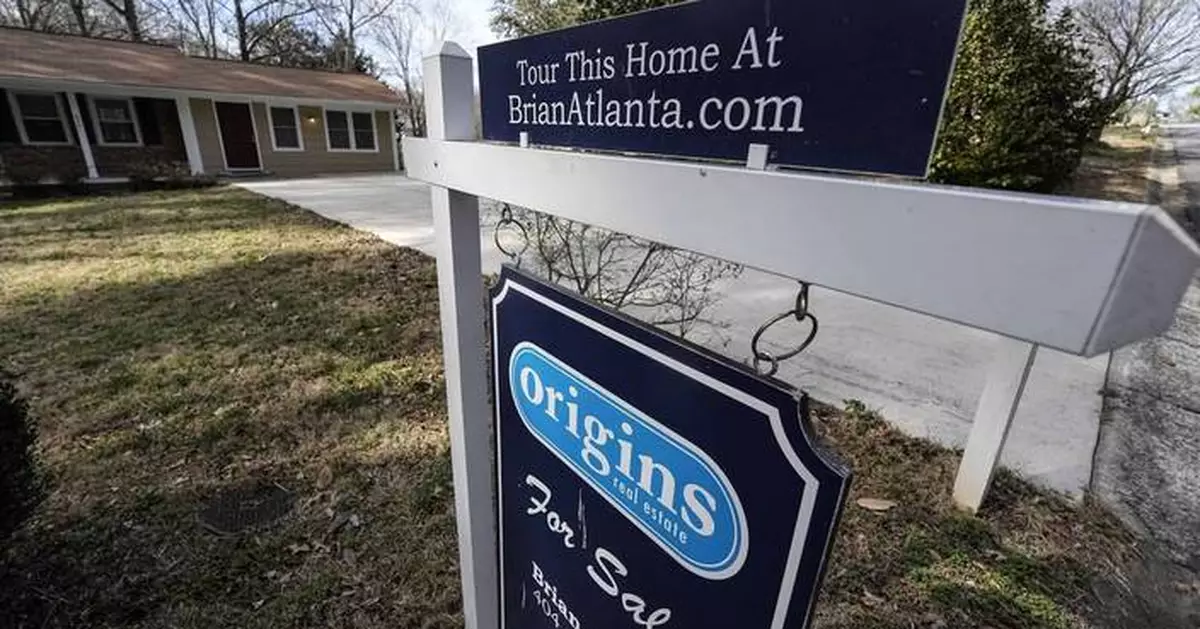LOS ANGELES (AP) — Prospective homebuyers are facing higher costs to finance a home with the average long-term U.S. mortgage rate moving above 7% this week to its highest level in nearly five months.
The average rate on a 30-year mortgage rose to 7.1% from 6.88% last week, mortgage buyer Freddie Mac said Thursday. A year ago, the rate averaged 6.39%.
When mortgage rates rise, they can add hundreds of dollars a month in costs for borrowers, limiting how much they can afford at a time when the U.S. housing market remains constrained by relatively few homes for sale and rising home prices.
“As rates trend higher, potential homebuyers are deciding whether to buy before rates rise even more or hold off in hopes of decreases later in the year,” said Sam Khater, Freddie Mac’s chief economist. “Last week, purchase applications rose modestly, but it remains unclear how many homebuyers can withstand increasing rates in the future.”
After climbing to a 23-year high of 7.79% in October, the average rate on a 30-year mortgage had remained below 7% since early December amid expectations that inflation would ease enough this year for the Federal Reserve to begin cutting its short-term interest rate.
Mortgage rates are influenced by several factors, including how the bond market reacts to the Fed’s interest rate policy and the moves in the 10-year Treasury yield, which lenders use as a guide to pricing home loans.
But home loan rates have been mostly drifting higher in recent weeks as stronger-than-expected reports on employment and inflation have stoked doubts over how soon the Fed might decide to start lowering its benchmark interest rate. The uncertainty has pushed up bond yields.
The yield on the 10-year Treasury jumped to around 4.66% on Tuesday — its highest level since early November — after top officials at the Federal Reserve suggested the central bank may hold its main interest steady for a while. The Fed wants to get more confidence that inflation is sustainably heading toward its target of 2%.
The yield was at 4.64% at midday Thursday after new data on applications for unemployment benefits and a report showing manufacturing growth in the mid-Atlantic region pointed to a stronger-than-expected U.S. economy.
“With no cuts to the federal funds rate imminent and with the economy still strong, there is no reason to see downward pressure on mortgage rates right now,” said Lisa Sturtevant, chief economist at Bright MLS. “It seems increasingly likely that mortgage rates are not going to come down any time soon."
Sturtevant said it's likely the average rate on a 30-year mortgage will hold close to 7% throughout the spring before easing to the mid-to-high 6% range into the summer.
Other economists also expect that mortgage rates will ease moderately later this year, with forecasts generally calling for the average rate to remain above 6%.
Mortgage rates have now risen three weeks in a row, a setback for home shoppers this spring homebuying season, traditionally the housing market’s busiest time of the year.
Sales of previously occupied U.S. homes fell last month as home shoppers contended with elevated mortgage rates and rising prices.
While easing mortgage rates helped push home sales higher in January and February, the average rate on a 30-year mortgage remains well above 5.1%, where was just two years ago.
That large gap between rates now and then has helped limit the number of previously occupied homes on the market because many homeowners who bought or refinanced more than two years ago are reluctant to sell and give up their fixed-rate mortgages below 3% or 4%.
Meanwhile, the cost of refinancing a home loan also got pricier this week. Borrowing costs on 15-year fixed-rate mortgages, often used to refinance longer-term mortgages, rose this week, pushing the average rate to 6.39% from 6.16% last week. A year ago it averaged 5.76%, Freddie Mac said.

FILE - A sign announcing a home for sale is shown on Feb. 1, 2024, in Kennesaw, Ga., near Atlanta. On Thursday, April 18, 2024, Freddie Mac reports on this week's average U.S. mortgage rates. (AP Photo/Mike Stewart, File)
BOCA RATON, Fla. (AP) — Florida's ban on most abortions after six weeks of pregnancy, before many women even know they are pregnant, went into effect Wednesday, and some doctors are concerned that women in the state will no longer have access to needed health care.
Dr. Leah Roberts, a reproductive endocrinologist and fertility specialist with Boca Fertility in Boca Raton, said the anti-abortion laws being enacted by Florida and other red states are being vaguely written by people who don't understand medical science. The rules are affecting not just women who want therapeutic abortions, meaning procedures to terminate viable pregnancies because of personal choice, but also nonviable pregnancies for women who want to have babies.
“We’re coming in between them and their doctors and preventing them from getting care until it’s literally saving their lives, sometimes at the expense of their fertility,” Roberts said.
The new ban has an exception for saving a woman's life, as well as in cases involving rape and incest, but Roberts said health care workers are still prevented from performing an abortion on a nonviable pregnancy that they know may become deadly — such as when the fetus is missing organs or implanted outside the uterus — until it actually becomes deadly.
“We’re being told that we have to wait until the mother is septic to be able to intervene,” Roberts said.
Besides the physical danger, there's also the psychological trauma of having to carry a fetus that the mother knows will never be a healthy baby, Roberts said.
“They’re feeling the kicks for months after they’re being told that they’re never going to have a live birth," Roberts said. “And it’s just horrifying when you could take care of it at 20 weeks, and they could move on, and they could get pregnant with their next pregnancy and be able to hold their babies that much sooner.”
She said a huge issue with the ban is that the doctors who perform emergency abortions have to learn the procedures by performing therapeutic abortions. So if most abortions are banned, the next generation of doctors won't be able to develop the skills needed to perform an emergency abortion.
Roberts said she's concerned the restrictions will also prompt veteran doctors to leave Florida, as they have in other states that have enacted abortion bans.
“We’re going to have less access to care for our general population, even if it’s just basic maternity care and normal OB-GYN care, because people are leaving,” Roberts said.
In addition, women are going to have to travel far from home to get abortions. Florida Access Network executive director Stephanie Pineiro said the organization, which helps provide funding for abortions, expects costs to increase dramatically. She estimates it will cost around $3,000 for a woman to travel to another state for an abortion. The closest place after 12 weeks would be Virginia or Illinois, but before 12 weeks would be North Carolina.
“It’s very emotionally draining and challenging to deal with these types of barriers and have to leave your home,” Pineiro said.
The Florida Supreme Court, with five of its seven members appointed by Republican Gov. Ron DeSantis, ruled 6-1 last month to uphold the state's ban on most abortions after 15 weeks of pregnancy, which cleared the way for the six-week ban. The 15-week ban, signed by DeSantis in 2022, had been enforced while it was challenged in court. The six-week ban, passed by the Legislature a year later, was written so that it would not take effect until a month after the 2022 law was upheld.
Republican state Sen. Erin Grall, who sponsored the six-week ban, previously said bodily autonomy should not include abortions.
“We live in a time where the consequences of our actions are an afterthought and convenience has been substitution for responsibility," Grall said, “and this is unacceptable when it comes to the protection of the most vulnerable.”
Voters may be able to enshrine abortion rights in Florida's constitution after a separate state Supreme Court ruling allowed a proposed constitutional amendment to be on the November ballot. The proposal says, “no law shall prohibit, penalize, delay, or restrict abortion before viability or when necessary to protect the patient’s health, as determined by the patient’s healthcare provider.” It provides for one exception that is already in the state constitution: Parents must be notified before their minor children can get an abortion.
Florida Democrats hope young voters would vote to enshrine abortion rights, as a way to combat the 900,000 voter registration edge Republicans have over Democrats in the state. They hope moderate views of the ballot initiative will turn out younger voters to vote Democrat when faced with the binary choice between a six-week abortion ban or protecting abortion until viability.
Jayden D'Onofrio, chairman of the Florida Future Leaders political action committee, said young Florida voters have a “real opportunity to shape the electoral landscape." Being that abortion rights have prevailed in elections nationwide, he thinks that Florida can engage young voters to register and vote for Democrats.
Nathan Mitchell, president of Florida Atlantic University College Republicans, said he would support a total abortion ban, and he hopes the amendment doesn't pass. Mitchell said he's seen most people want restrictions on abortion, usually for bans within 10 to 15 weeks of gestation.
Most Republican-controlled states have adopted bans or restrictions on abortions since the U.S. Supreme Court overturned Roe v. Wade in June 2022. A survey of abortion providers conducted for the Society of Family Planning, which advocates for abortion access, found that Florida had the second-largest increase in the total number of abortions provided since the decision. The state’s data shows that more than 7,700 women from other states received abortions in Florida in 2023.
Florida Democratic leaders are encouraging women to seek help from abortion funds and resources. On Tuesday, Senate Minority Leader Lauren Book encouraged women to access abortion travel funds and urged them to avoid “taking matters into your own hands.”
Matat reported from West Palm Beach, Florida.

FILE - Florida Gov. Ron DeSantis answers questions from the media, March 7, 2023, at the state Capitol in Tallahassee, Fla. Florida's ban on abortions after six weeks of pregnancy, before many women even know they are pregnant, went into effect Wednesday, May 1, 2024. The Florida Supreme Court, with five of its seven members appointed by DeSantis, ruled 6-1 last month to uphold the state's ban on most abortions after 15 weeks of pregnancy, which cleared the way for the six-week ban. (AP Photo/Phil Sears, File)

Dr. Leah Roberts, a reproductive endocrinologist-fertility specialist, discusses Florida’s six-week abortion ban, which took effect Wednesday, May 1, 2024, in her office and laboratory in Boca Raton, Fla., Tuesday, April 29. (AP Photo/Daniel Kozin)

Dr. Leah Roberts, a reproductive endocrinologist-fertility specialist, discusses Florida’s six-week abortion ban, which took effect Wednesday, May 1, 2024, in her office and laboratory in Boca Raton, Fla., Tuesday, April 29. (AP Photo/Daniel Kozin)

Dr. Leah Roberts, a reproductive endocrinologist-fertility specialist, looks through a microscope while discussing Florida’s six-week abortion ban, which took effect Wednesday, May 1, 2024, in her office and laboratory in Boca Raton, Fla., Tuesday, April 29. (AP Photo/Daniel Kozin)

Dr. Leah Roberts, a reproductive endocrinologist-fertility specialist, discusses Florida’s six-week abortion ban, which took effect Wednesday, May 1, 2024, in her office and laboratory in Boca Raton, Fla., Tuesday, April 29. (AP Photo/Daniel Kozin)















